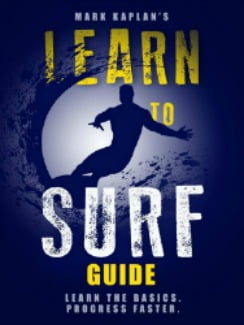Surfing is Timing and Rhythm
New surfers learn that surfing is timing and rhythm. From beginner to advanced surfers learn that catching waves and riding them is about the timing and rhythm of both movement and sensing what is happening in the wave.
Coaches for professional surfers often stress that surfers should feel what is happening in the wave and time their maneuvers and tricks to what the waves are giving them. Beginners learn to wait for good waves and get in position t ride them.

The Fundamentals of Catching and Riding Waves
The beginner surfer spots a good foam wave as it lines up in a straight line and comes to the beach without any turmoil in front of it. The surfer rolls over 20′ before the wave arrives and begins to paddle to get momentum. When the wave is a few feet away, the surfer paddles hard to accelerate and get in front of the wave. As he feels the board take off, he puts his hands on it.
The advanced surfer often studies the waves before he goes in the water. He wants to know how they are breaking. Every beach is different and waves vary in different tides. Kelly Slater was a master at studying and then planning his strategy. The surfer then knows where to position himself so he will be in the right place to catch the wave as it breaks.
Surfers let real waves roll under their board and before it peaks, they paddle hard a few times to get the board going down the face. At this point the board is dropping below their body to allow a nice pop up. On waves that close out because they are on sand bar beaches, surfers will often point the nose toward the pocket after they have caught the wave and before they pop up.
On real waves, surfers accelerate two or three times in the pocket before performing a maneuver or trick and then do the same afterward. This is a rhythm where the surfer is looking at what the wave is giving him. He has a routine in his head that he strategized before going in the water of what he wants to work on or what he wants to perform in a contest.
Coaches want their surfers to be adaptable and capable of surfing in all conditions and types of waves. Going out on bad days might be great practice for the good days by making a surfer more adaptable to conditions. A surfer would like to feel that he is at one with the waves or in a state of flow where he doesn’t have to think but reacts to what he sees.
Learn More
For Oceanside Surf Lessons, see the Home Page
See the Post Surf Lessons Begin with Foam Waves
See the Post What You Learn in a 2 Hour Lesson
See the Post How to Progress in Surfing
See My Dry Land and In Water Demo video
See How to Catch a Green/Real Wave video
i have lowered my book and course prices for the lock down.
My New Surfing Course in an E-Book plus Demo Video
Get the 18 Chapter, 7,500 word Course that can prepare you for a lesson or give you the fundamentals if you are going to try it on your own. 10 years of teaching 350 students a year has given me the insights on the most precise measures you must follow for success. This course is what I teach on the dry land and in water instruction. The Course includes a 15 minute video on my dry land and in water demonstration. Only $4.95
Buy the E-book for $2.99. Learn to Surf (Different cover but same book)
Buy the Paperback on Amazon $6.95
Get Learn to Surf Course in 29 minute audio. Great prep for a lesson, reviewing after a lesson, learning on your own, refreshing after not having surfed for a while. See Table of Contents. Only $7.95

80 page Learn to Surf Book
![Surf Instructions Beginner to Advanced: Learn to Ride Waves by [Kaplan, Mark]](https://images-na.ssl-images-amazon.com/images/I/51HswFtoBQL.jpg)